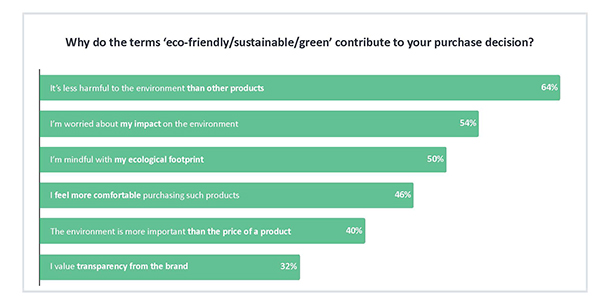Why You Need to Care About Your Ecological Footprint
After years of lip service about doing better for the environment, consumers are taking action. They are putting their habits under a microscope and making changes, from recycling personal care packages to toting reusable shopping bags. They consider a brand’s sustainability commitment as a reason to buy—or not.
Consumers are doing their share, and the pressure is on for beauty brands to do the same.
The importance of “going green” is underscored by CEW’s latest series highlighting Bazaarvoice’s surveys of its Influenster community, which analyzes consumer shopping behavior. The most recent findings elevate the importance of fusing beauty and the environment. Click here for a breakdown of the full report.
Sustainability Builds Loyalty and Shopping Baskets
Close to 80% of the Influenster’s community indicated they feel it is very/somewhat important that the brands they use are either green, eco-friendly and/or sustainable. The survey, composed of over 8,000 consumers, suggests that brands must make awareness of the environment mission critical.
There is a disconnect when it comes to grading brands’ efforts. Only 18% of the surveyed respondents feel companies are “mindful” of their ecological footprint.
Doing right by the environment can even outweigh performance for respondents. One in three would still choose to buy eco-friendly/sustainable/green products, even if performance was not as effective as other products. That debunks conventional wisdom that shoppers don’t shop green at the cost of efficacy.
People aren’t letting price deter their motives. One in four would pay more for eco-centric products. Gen Z is the most vocal cohort with 76% indicating they’d dig deeper into their pockets; 65% agreed with the sentiment that they’d pay more.
Brand loyalty is threatened for those that don’t put a focus on global resources. Eighty-six percent of participants would buy a product from a new brand that claims to be sustainable, over their “go to” favorite. Baby boomers are the most enthusiastic about switching to an eco-minded brand. This opens the door for nascent brands to compete against legendary multinationals.
Seventy-five percent of respondents strongly agree/agree that they are more inclined to use products made from recycled and sustainable materials. When they prioritize the categories where it is important, skin care and hair care are the second highest (68% and 61%) and cosmetics ranks third (56%).
Yet skin care, hair care products and cosmetics are low on the categories that are being recycled, refilled or repurposed—perhaps due to a lack of options. Skin care and hair care products are recycled 40% of the time; cosmetics 33%. In comparison, 76% of drink containers and bottles get recycled, refilled or repurposed.
People are taking action. The majority feel it is very/somewhat important to them that the brands/products they use are either green, eco-friendly or sustainable.
Respondents agree that brands also have a responsibility to protect the people and the planet by investing in sustainable programs, too. Eighty-four percent of those weighing in put the onus on brands. One in two consumers feel that it depends on the company’s ethos whether a brand is mindful of its ecological positioning.
The bottom line: Influenster results suggest consumers evaluate their purchase decisions on a brand’s eco-friendliness. They want companies to let them know of their commitments with visible verbiage on products, such as eco-friendly, sustainable or green. Almost 70% feel it is important to their purchase decisions that a product is marketed as eco-friendly, sustainable or green.

How Brands Can Be More Eco-Friendly
The message is clear: Consumers want to find alternatives to harming our eco-system. They’ve seen the damage caused by single-use disposable products. They are carrying their own bags more often to shop, in order to curb plastic use—74% agreed they are trying to remember to do that small task.
They are ready to do more. 80% of the survey respondents strongly agree/agree that they are looking for options. And they are voting with their wallets: 68% indicate they strongly agree/agree that they have been trying to buy more from sustainable and eco-friendly brands.
Brands can ease that journey with transparent packaging. In fact, 28% of those surveyed say they always pay attention to labeling and 66% at least sometimes make sure they eyeball labels.
Consumers are actively educating themselves on how to be eco-friendlier. More than 80% of those surveyed believe they understand the terms of green, eco-friendly and sustainable.
Influenster respondents indicate they search for information on websites, blogs and social media to form their own opinions of companies’ green initiatives.
Sixty-two percent of the survey respondents will sometimes search for information on brand websites, blogs and social media to dig into what companies are doing to be eco-friendlier, sustainable of what their green initiatives include. More than 50 percent indicate they would watch brand videos explaining their commitment to sustainability, carbon consumption, ingredient/sourcing and other initiatives.
All generations, except Gen Z, turn to brand websites and browser searches for information. (Gen Z prefers Instagram and YouTube).
The brands that do have sustainability messages are doing a good job, with 76% of respondents saying they are confident, assured, and happy by the information they receive from brands’ websites, blogs/and or social media highlighting sustainability efforts.
It is a team effort between shoppers and brands to create a better planet.
For the full report of Influenster’s in-depth research, click here.
Check out Bazaarvoice’s new website to learn how you can activate the Influenster community for your brand.




